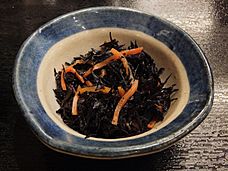Hijiki facts for kids
Quick facts for kids Hijiki |
|
|---|---|
| Scientific classification | |
| Genus: |
Sargassum
|
| Species: |
fusiforme
|
Hijiki (ヒジキ, 鹿尾菜 or 羊栖菜, hijiki) (Sargassum fusiforme) is a type of brown sea vegetable. It grows naturally on rocky coastlines in East Asia. People sometimes call it hiziki.
For hundreds of years, hijiki has been an important part of the Japanese diet. It is full of dietary fiber and important minerals. These include calcium, iron, and magnesium. Old Japanese stories say that eating hijiki helps with health and beauty. They also say it can make your hair thick, black, and shiny.
Hijiki has been sold in natural food stores in the United Kingdom for many years. Its use in cooking has also become popular in North America. However, some studies show that hijiki can contain high levels of a natural substance called inorganic arsenic. Because of this, food safety groups in countries like Canada, the United Kingdom, and the United States suggest not eating it. Japan does not have this same advice.
Contents
Hijiki in Western Countries
The word "hijiki" first appeared in an English book in 1867. This book was called A Japanese and English Dictionary. It was written by James Curtis Hepburn.
In the 1960s, hijiki started to become more widely known in the United States. Dried hijiki was imported from Japan. You could find it in natural food stores and Asian grocery stores. This was partly because of the macrobiotic movement. In the 1970s, as more Japanese restaurants opened, hijiki became even more popular.
What Hijiki Looks Like and How to Prepare It
When hijiki grows in the ocean, it is green to brown in color. Fishermen and divers collect hijiki using a sickle. They usually do this during low tide in May, from March. After it is collected, the seaweed is boiled and then dried. This dried hijiki is what is sold in stores, and it looks black.
To cook dried hijiki, you first soak it in water. Then, you can cook it with other ingredients. Often, it is cooked with soy sauce and sugar to make a tasty dish.
How Hijiki is Eaten Around the World
In Japan, hijiki is usually eaten with other foods. These can include vegetables or fish. It can be added to steamed or boiled dishes. People also marinate it in soy sauce or fish sauce. Sometimes, it is cooked in oil, added to soups, or used in stir-fries or quiches.
Hijiki seaweed can be mixed with rice for sushi. However, it is not used as the wrap for sushi rolls. In Japan, a jelly-like food called Konjac (konnyaku) often has hijiki mixed in. This gives it its special gray color and texture.
In Korea, this seaweed is called tot (톳). It is eaten as namul, which is a seasoned vegetable side dish. It is also cooked with bap (rice).
Nutrition and Health Benefits
Hijiki contains dietary fiber and important minerals. These minerals include iron, calcium, and magnesium. Dietary fiber is good for your intestines and helps with digestion. Iron helps to prevent anemia, a condition where your blood doesn't have enough healthy red blood cells.
Hijiki has a good balance of calcium and magnesium. The amount of calcium is about twice the amount of magnesium.
See also
 In Spanish: Sargassum fusiforme para niños
In Spanish: Sargassum fusiforme para niños




